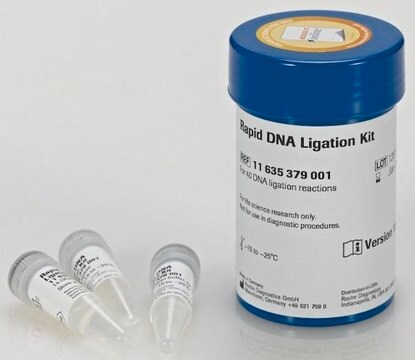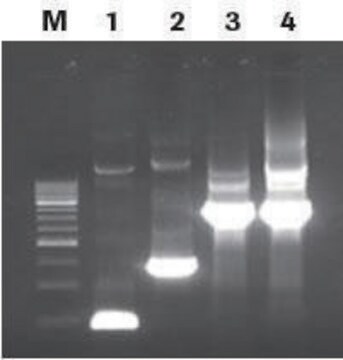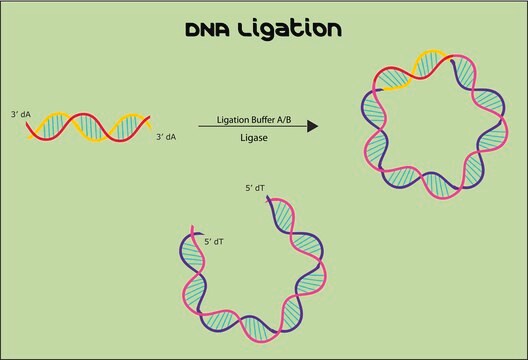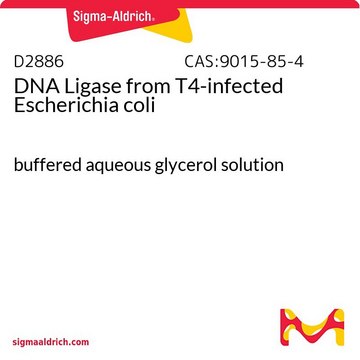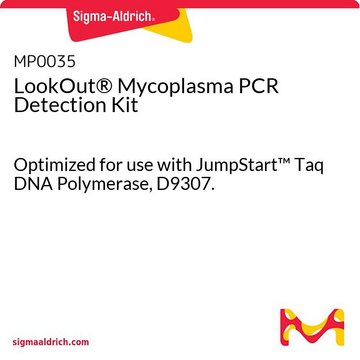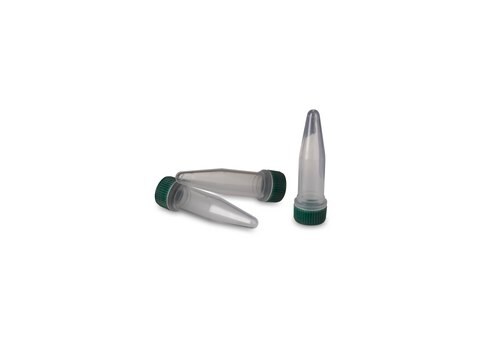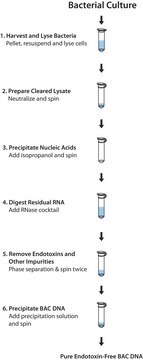About This Item
UNSPSC Code:
12352204
NACRES:
NA.53
Productos recomendados
grade
for molecular biology
usage
kit sufficient for 150 ligation reactions
shipped in
wet ice
storage temp.
−20°C
General description
Sigma′s DNA Ligation Kit contains all of the reagents necessary to perform DNA ligation reactions. Sticky-end ligations are more efficient than blunt-end ligations; these can be facilitated with the addition of PEG.
Application
Suitable for:
- Joining fragments of DNA into a cloning vector
- Mutagenesis
- Gene anyalysis and structure-function relationships
Components
Sufficient for 150 reactions:
- 300uL 10X Ligation Buffer (D2176) in 250 mM Tris-HCl (pH 7.8) 100 mM MgCl2, and 10 mM dithiothreitol
- 3 x 100 units T4 DNA Ligase (D2886) in 50% glycerol with 10 mM Tris-HCl (pH 7.5) 50 mM KCl, and 1 mM dithiothreitol
- 3 x 100 uL 10 mM ATP ( A3702)
- 50 uL Control pBR322 DNA, HAE III Digest (D9430) 0.5 ug/ul in 10 mM Tris-HCl (pH 8.0), and 1 mM EDTA
- 1.5 mL 24% (w/v) PEG Solution, (P 2454)
- 1.5 mL Molecular Biology Grade Water (W4502)
Principle
One of the most important steps in the cloning process is the ligation of linear DNA into a cloning vector. DNA ligations are performed by incubating DNA fragments with appropriately linearized cloning vectors in the presence of buffer, ATP, and DNA ligase. Many parameters affect ligations such as the relative ratio of insert to vector, the quality and type of the DNA ends, the temperature of ligation and the concentration of DNA.
Related product
signalword
Warning
hcodes
Hazard Classifications
Eye Irrit. 2
Storage Class
10 - Combustible liquids
wgk_germany
WGK 3
flash_point_f
Not applicable
flash_point_c
Not applicable
Certificados de análisis (COA)
Busque Certificados de análisis (COA) introduciendo el número de lote del producto. Los números de lote se encuentran en la etiqueta del producto después de las palabras «Lot» o «Batch»
¿Ya tiene este producto?
Encuentre la documentación para los productos que ha comprado recientemente en la Biblioteca de documentos.
Sambrook, J., et al
Molecular Cloning: A Laboratory Manual, 2, 1-1 (1989)
Ausubel, F. M.
Current Protocols in Molecular Biology, 1, 3-3 (1994)
Bradley J Eckelmann et al.
NAR cancer, 2(3), zcaa013-zcaa013 (2020-08-11)
Homologous recombination/end joining (HR/HEJ)-deficient cancers with BRCA mutations utilize alternative DNA double-strand break repair pathways, particularly alternative non-homologous end joining or microhomology-mediated end joining (alt-EJ/MMEJ) during S and G2 cell cycle phases. Depletion of alt-EJ factors, including XRCC1, PARP1 and
Nuestro equipo de científicos tiene experiencia en todas las áreas de investigación: Ciencias de la vida, Ciencia de los materiales, Síntesis química, Cromatografía, Analítica y muchas otras.
Póngase en contacto con el Servicio técnico